The waterbuck is a large, reddish-brown and grey antelope, native to Africa. Their long, ringed horns, and the ‘painted’ white rings on their rumps make them easily identifiable.
Their name suggests that they live in mostly aquatic homes like their amphibious cousins the lechwe and sitatunga. But that’s not quite true. Rather, their name seems to stem from the fact that they have a preference for living near to permanent water sources.
So why do they love water so much? And why have they evolved their mysterious markings?
There’s a lot to discover about these gregarious and beautiful African antelope. Here’s a guide to the interesting facts and general information, so you can learn all about the wonderful waterbuck.
What is a Waterbuck (Kobus Ellipsiprymnus)?
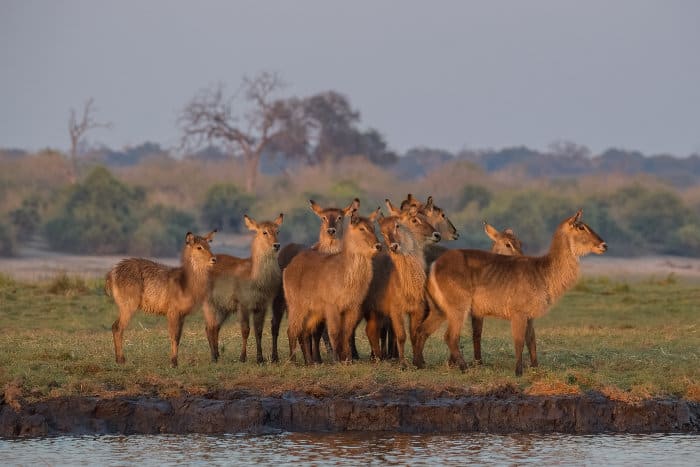
The African waterbuck is a large antelope found in Western, Eastern, and Southern Africa. They are the largest of the kob antelopes in the Bovidae family.
This species of buck is scientifically named Kobus ellipsiprymnus, and consists of the common waterbuck (Kobus ellipsen ellipsiprymnus), and the defassa waterbuck (Kobus ellipsiprymnus defassa). They were previously regarded as two separate genera, however, are now divided into these two subspecies.
What Does a Waterbuck Look Like?
The waterbuck boasts a rough coat, with long shaggy hair under its throat and a mane on its neck. They are well-known for their trademark white patterns around the hindquarters.
The body color ranges from light gray to red-brown and darkens with age. These antelopes have large, rounded ears, and beautiful white markings around their necks, nose, mouth, and above the eyes.
Size
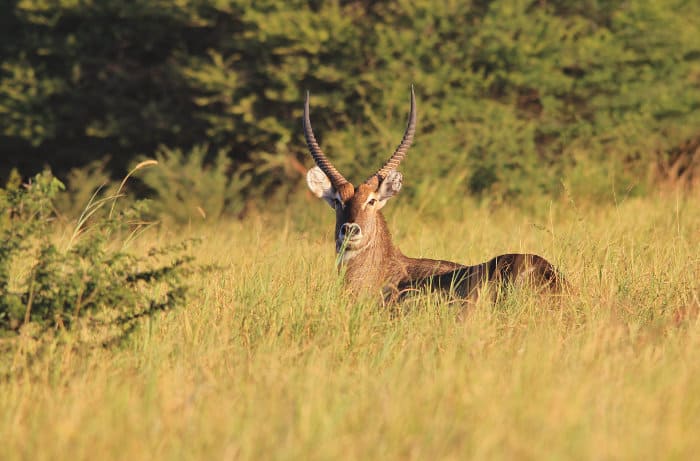
Waterbucks are stocky, with short legs and long bodies. The bulls can reach up to 136 cm tall at the shoulder, while females reach up to 120 cm.
Weight
The weight of a waterbuck varies between males and females.
Adult males are significantly heavier than their female counterparts. A typical bull can weigh between 200 and 300 kilograms, while the females weigh between 160 and 200 kilograms.
Common Waterbuck vs. Defassa Waterbuck
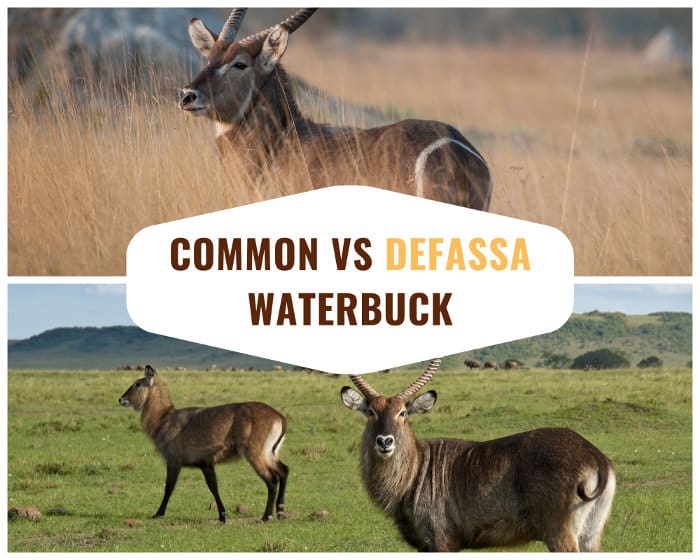
The common waterbuck lives in Southeast Africa, east of the Great Rift Valley. While the defassa waterbuck’s home is primarily in East and West Africa, west of the Great Rift Valley.
Although both of these subspecies are equally remarkable, there are some physical differences that separate them.
Physical differences
Aside from the difference in geographic range, the easiest way to distinguish between the two subspecies is simple (though you may need to ask them to turn around):
The defassa waterbuck does not have a target-like white ring on his backside like his common waterbuck cousin. Instead, he has two solid ring patches on either side of his rump.
Habitat
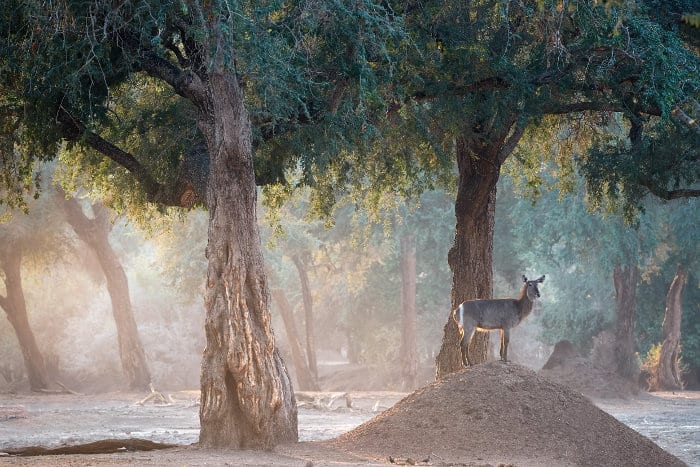
A waterbuck’s habitat varies depending on the quality of the area, proximity to a water source, and their health.
These bucks are mostly found in savanna grasslands, riverine forests and woodland areas. They have a vast territory, often shared by many females, one dominant territorial male, and a number of non-territorial males.
Waterbuck are gregarious animals and live together in herds of 6 to 30 individuals. These are either bachelor herds (young males) or nursery herds with females and their calves. Once a male starts to mature, he will move off to establish his own territory that is rich in food supply.
These herbivorous animals have remarkably high water requirements. They need to drink often, which is one reason why they remain close to permanent water points at all times. You’ll often find them nestled in reed beds near rivers and dams, or on floodplains.
Bull vs. Cow
Waterbuck are sexually dimorphic, meaning males and females have external differences apart from their reproductive organs.
Males can be up to 25% larger than their female counterparts and they carry the defining feature of beautiful, long, ringed horns.
These horns curve backwards and then forward and vary in length from 55 cm to 99 cm. The age of the bull determines the length of the horns.
Waterbuck horns will begin to develop at around 8 to 9 months and mark the young buck’s time to separate from the herd. Young males form bachelor groups remain together until they mature and move on to make their own herd.
What Do Waterbucks Eat?
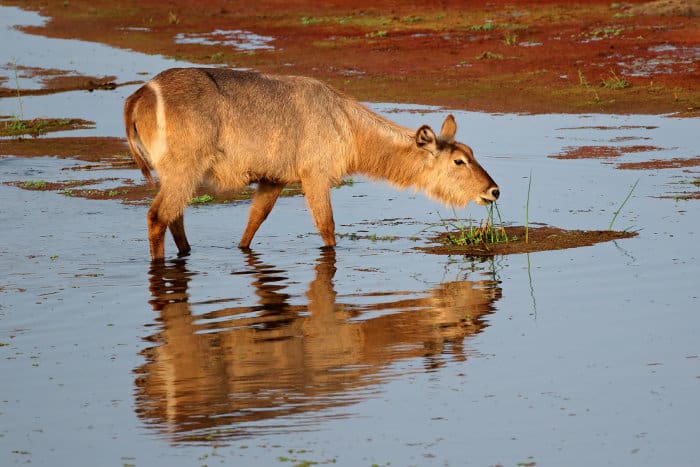
Waterbucks’ diets are rich in protein and other nutrients. This includes coarse grasses that are seldom eaten by other plain animals, and long sweet grasses like buffalo grass.
During the dry season, they supplement their diet by browsing on leaves from shrubs and certain trees, such as the Sweet thorn (Vachellia karroo). At times, you will find them shoulder-deep in water, eating roots and other aquatic plants.
They also enjoy browsing on certain fruits, especially the marula fruit during the ripe season.
These antelope typically eat in the mornings and late afternoons and chew cud for the remainder of the day.
Understanding the Waterbuck’s Life Cycle
The mating season peaks during winter, though it can occur at low intensity throughout the year. And this is where the waterbuck’s life cycle begins.
Gestation period of waterbuck
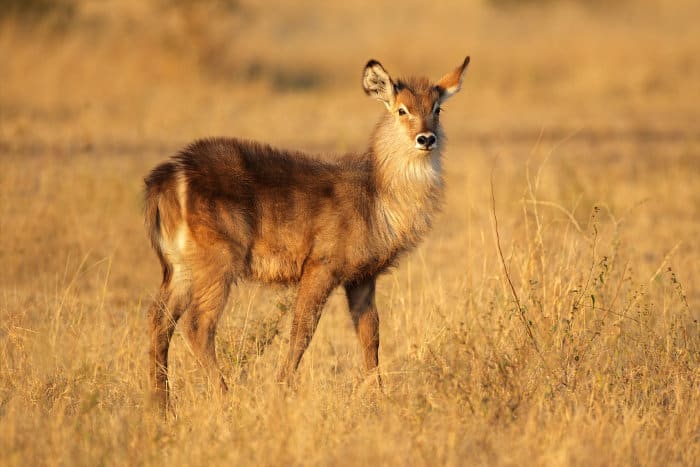
Male waterbuck mature at the age of six years, and females reach maturity at three years. Although females may conceive by the age of two and a half years.
The gestation period lasts for about nine months. After which, the female will give birth to a single calf.
Waterbuck lifespan
A few days before calving, the mother will isolate herself in the thickets. After birth, it will take the newborn around half an hour to stand on its feet and to have its first suckle.
The young calves will remain hidden in the thickets for around two to four weeks before they join their mother in the fields.
Mothers nurse their calves for as long as six to eight months. They are then weaned off and both mother and calf will join the herd. Often calves find groups their age to spend most of their time with.
Waterbucks can live up to twelve years in the wild, and eighteen years in captivity.
Predators
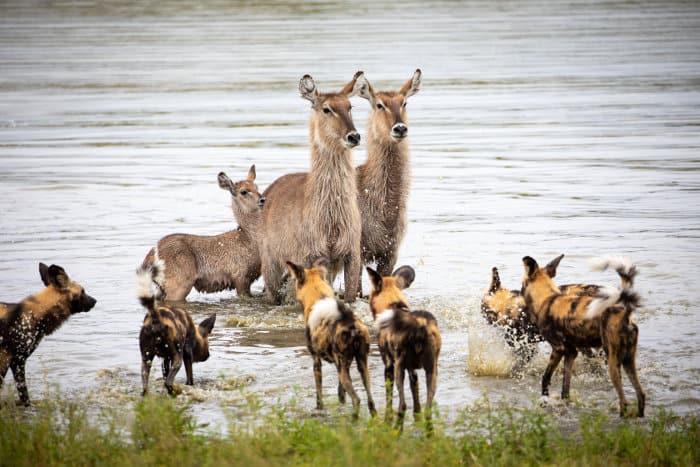
Waterbucks have a variety of predators that they need to keep a lookout for. Their lives are often short-lived due to the impact of predators.
Who are waterbuck predators?
Their predators mostly consist of lions, leopards, hyenas, and occasionally crocodiles. They often attack the waterbucks’ newborn calves as well as older, slower bucks.
Humans also pose a threat to these animals and are infringing on their habitats. Unfortunately, they are mostly trophy hunted for their horns and hides.
How do waterbucks escape predators?
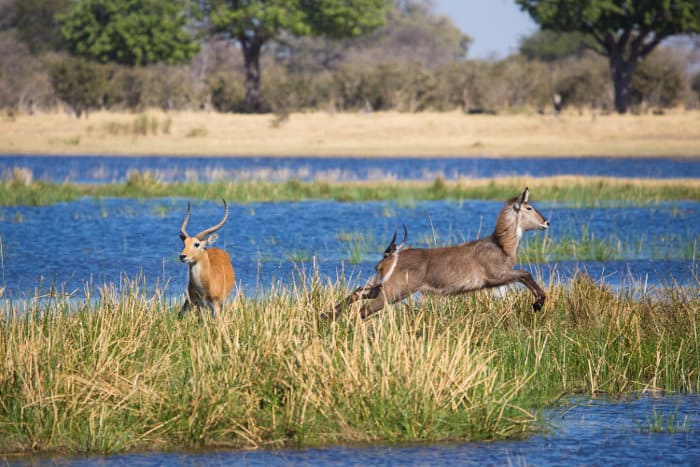
These beautiful animals depend a lot on taking cover and refuge from predators as they lack endurance.
In the presence of danger, these animals often snort to alarm the rest of their group. The herd will then quickly flee the scene. These bucks also cleverly escape from predators by rushing into the water where they are generally safest.
Are Waterbucks Endangered?
The common waterbuck species has a reasonably stable population, and the IUCN has listed them as least concerned.
On the other hand, the IUCN has listed the defassa waterbuck as near threatened.
Waterbucks have an estimated global population headcount of 200,000. Records from 1999 show that this comprised 95,000 defassa waterbuck and 105,000 common waterbuck.
Fun Waterbuck Facts
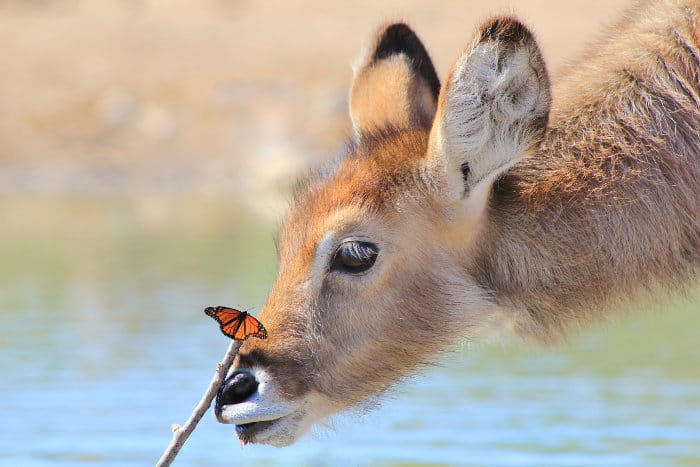
Hungry for more? Here are some quick-fire fun facts about these beautiful animals.
- Male waterbucks use their horns to fight and defend their territories.
- These antelopes can clock speeds of up to 50 km/h.
- Waterbucks are quiet creatures. They mostly communicate visually with what is known as the ‘flehmen response‘.
- The meat of older waterbuck has an unpleasant smell due to the secretions from its sweat glands.
- They change their feeding patterns depending on age, sex, season, and distance from water.
- As a protective instinct, the mothers will often eat the afterbirth to avoid attracting predators.
- Mothers communicate with their calves by bleating and snorting.
- Waterbucks are both nocturnal and diurnal, meaning that they’re active during both the day and the night.
Myths About the Waterbuck
These species have plenty of myths following their appearance. Here are two that stand out from the rest.
- According to African folklore, the meat of the waterbuck is not edible. The truth is that while the meat is not very tasty, it is safe to eat.
- The white ring around the waterbuck’s hindquarters has led to many tales. A favorite is that they were the first animals to use the toilet on Noah’s Ark. The newly-installed toilet seats on the ark were still wet with paint and left a distinctive white ring on their rumps.
The African Bucks with Comically Painted Backsides
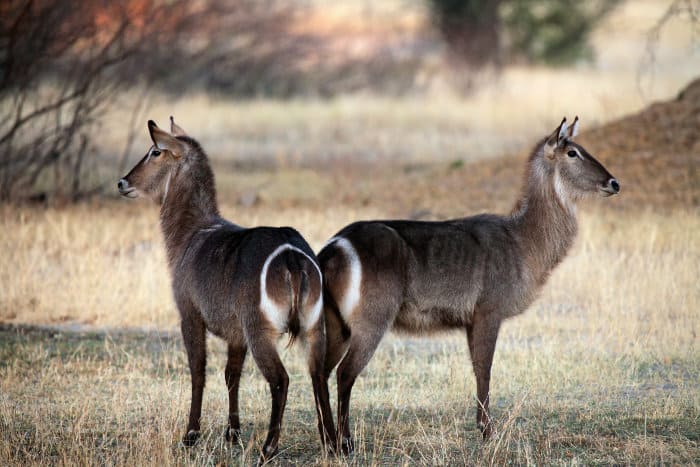
Some markings on the waterbuck are subtle like those on the greater kudu. While other markings, like the ones on their hindquarters, are more prominent.
Despite these bucks being a part of the ‘butt joke’, there are valid reasons for the white markings on their hindquarters. Flashes of color often scare off predators and can act as a ‘follow me’ sign, helping other waterbucks to flee when in danger.
If you’re interested in seeing these quiet, sedentary antelopes in their natural habitats, book a tailor-made safari to see them in Africa.
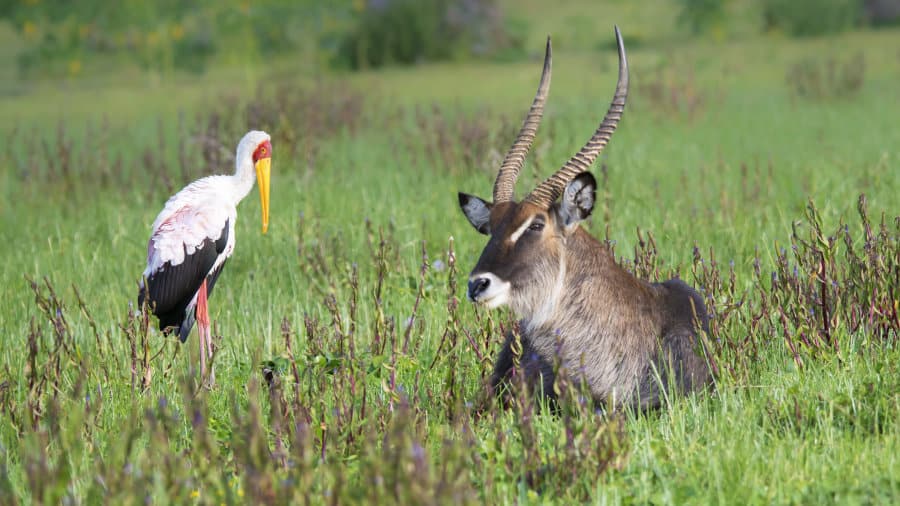
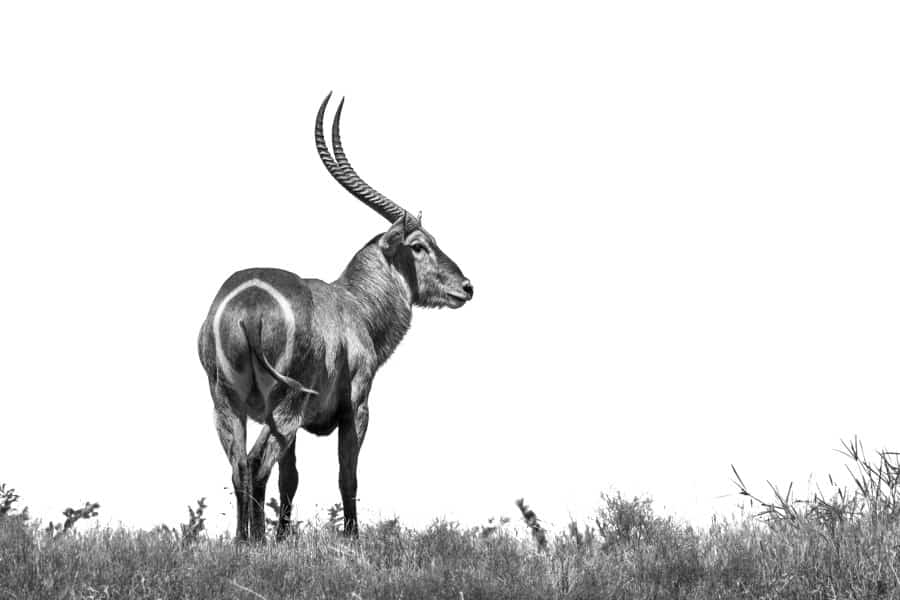
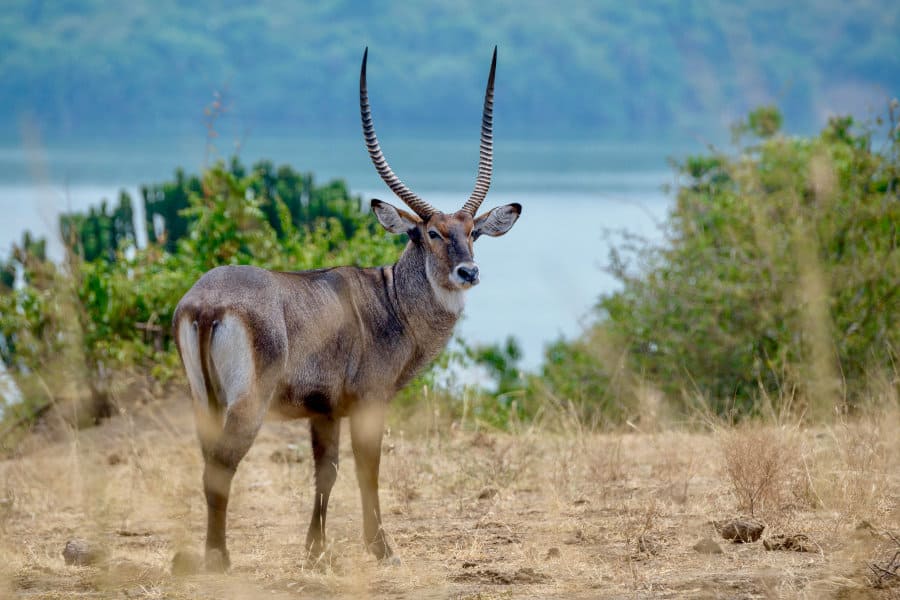
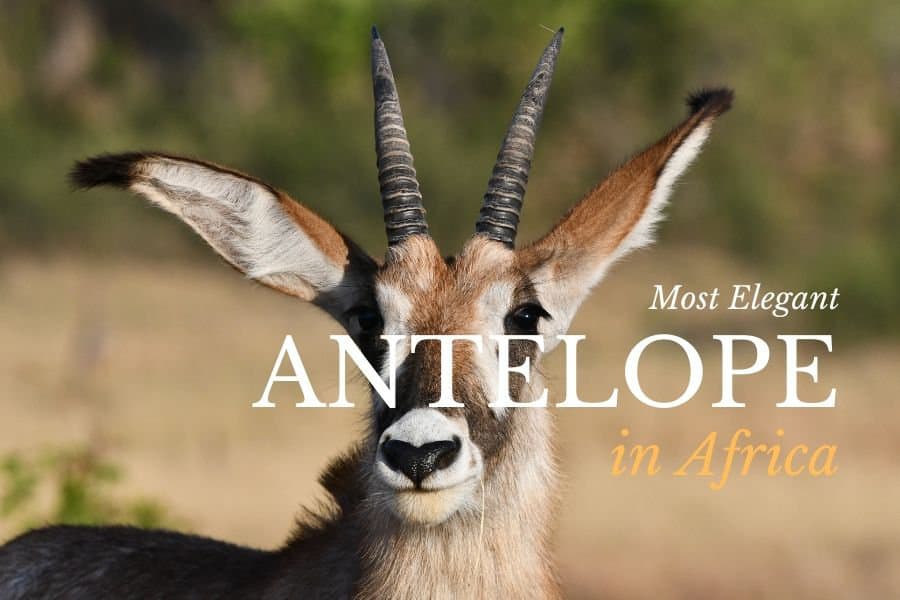
I like the detailed information on the waterbuck. Thank you so much.